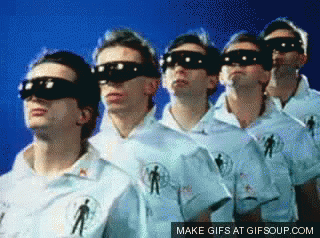
An update from the 50's or 'We are DEVO'?


Posted on 05/27/2020 7:25:20 AM PDT by Kaslin
Amid the pandemic, the SpaceX launch should inspire us to be risk-takers, trying new things and starting new ventures. We can only achieve great things if we don't let fear dictate how we live our lives.
Two American astronauts, Doug Hurley and Bob Behnken, will strap themselves in the Dragon capsule, which sits on top of the Falcon 9 rocket — both built by Elon Musk’s company SpaceX — and depart for the International Space Station on May 27.
This extraordinary event embodies much historic significance. The Falcon 9 rocket will be launched from the same launch pad at the Kennedy Space Center that has sent many missions to space, including Apollo 11, which carried Neil Armstrong, Buzz Aldrin, and Michael Collins to the moon in 1969, sealing a victory for the United States in the Cold War space race against the Soviet Union.
Without a fierce competitor after the Soviet Union crumbled, the U.S. government’s priorities shifted, and the space program started winding down. In an incredible turn of events, U.S. astronauts had to hitch a ride with the Russians on Russian soil in order to reach the International Space Station.
This Wednesday’s launch will mark the first time in nearly a decade that American astronauts will be sent into space from American soil. Even more significantly, it will be the first time ever in history that a private American company — founded by an immigrant, no less — built the capsule and rocket for the mission.
The timing of this launch is also significant. The ongoing pandemic has infected 1.7 million Americans, killing about 100,000.
In the meantime, more than 36 million Americans are out of jobs as the result of lockdown measures. I especially feel for young people. At an age when they should be worry-free, their in-person classes, proms, and graduation ceremonies are canceled, and their job opportunities are drying up. The Wall Street Journal reports that in April, the “unemployment rate for teens aged 16 to 19 hit 32%, marking a high not seen since at least 1948.”
The national state of mind is solemn, shaken, and uncertain. We don’t know when our lives will get back to normal, and our definition of normal has become blurry. We are told the Wuhan virus is here to stay, and we need to abide by all the safety measures. Are masks, social distancing, and takeout the norm for the rest of our lives?
As our nation and people struggle to reclaim our way of life, seeing SpaceX’s Wednesday launch might fire up our imagination and offer us new hope for the future. We can achieve great things when we are willing to take risks. If worse comes to worst, at least some of us might be able to spend the next pandemic lockdown on Mars. It’s not fantasy but a distinct possibility, thanks none other than Elon Musk.
Musk’s journey to the Kennedy Space Center is remarkable and inspiring. Musk, an immigrant from South Africa, studied business and physics at the University of Pennsylvania. He went on to pursue a Ph.D. in energy physics at Stanford University.
He was in the right place at the right time — the internet had just become the next big thing, and Silicon Valley was the place to be. After spending only two days at Stanford, Musk dropped out to start his first company, Zip2 Corporation, in 1995 at the ripe age of 24, with $2,500 cash, one computer, a car he bought for $1,400, and $100,000 in student loan debt.
Four years later, in 1999, Musk sold his first company for $300 million, right before the dot-com bubble burst in 2000. Then he set up an internet payment company, now known as PayPal, and later sold his shares to eBay for $200 million.
Musk could have spent his millions and enjoyed life. Instead, he reinvested everything he had, in addition to borrowing capital to fund not one but two new business ventures: Space Exploration Technologies (SpaceX) in 2002 and a year later Tesla, the electric car company.
Space programs are not only technically demanding but also expensive, which explains why they are out of reach for many countries. With SpaceX, Musk is seeking to make space flight more affordable by building rockets that can land safely and be reused, like an airplane.
Of course, many critics told Musk what he wanted to achieve was simply impossible. SpaceX experienced many failures in the early years. Musk hit a low point in his life and career in 2008. He almost had a nervous breakdown while sleeping in his friend’s spare room, estranged from his wife and family.
Mark Harris, a space journalist who closely observes Musk and SpaceX, expressed, “Musk has launched SpaceX on its trajectory through sheer force of will. He hires the best engineers and works alongside them with an intensity unmatched by the other billionaires.” Musk is a well-known workaholic who typically works 100 hours a week. He is known to spend many nights either in his office or even sleeping on the factory floor. His work ethic and intense focus have been the main factors for several of his failed relationships.
In the end, Musk’s drive, focus, and hard work paid off. In September 2008, SpaceX became the first privately owned company to send a liquid-fueled rocket into orbit. NASA awarded a contract worth more than $1 billion to SpaceX. In December 2010, SpaceX became the first private company to send its Dragon capsule spacecraft into orbit and successfully return it to Earth.
The Dragon also became the first privately built spacecraft to dock with the International Space Station, which laid the foundation for this Wednesday’s launch. Musk not only achieved what many told him was impossible, he cut the cost of entering space significantly: Now it costs close to $1,000 per pound, less than 4 percent of what it used to.
SpaceX’s drastic cost reduction and technological advancements have expanded opportunities for space exploration. The company is now one of three in the running to send Americans back to the moon.
Musk says his ultimate goal is to colonize Mars. He has said he wants to die on Mars, “just not on impact.” In a typical showy way, at the inaugural flight of the Falcon Heavy rocket in 2018, Musk sent a red Tesla Roadster car with a spacesuit-clad mannequin named Starman behind the wheel, with the car’s radio playing David Bowie’s “Life on Mars” on repeat. Space fans estimate that if the car’s battery is still working, Starman would have heard the song more than 150,000 times. Hopefully he’s not getting too bored.
Musk became a U.S. citizen in 2002. In an interview with Bloomberg News, he credited his adopted country with his success, saying, “America is still the land of opportunity more than any other place, for sure. There is definitely no other country where I could have done this — immigrant or not.” The success of SpaceX is truly a testament to the superiority of a free-market economy and what free people can achieve when they can choose, create, pursue, and take risks.
Musk is no Captain America. His flaws are as visible as his outsized achievements. Especially on Twitter, he often comes across as arrogant, aggressive, flamboyant, and quarrelsome. He has gotten into trouble more than once on social media, including paying a $40 million fine and relinquishing his Tesla chairmanship after tweeting about securing funding to take Tesla private, which turned out not to be true. Still, Musk’s drive, focus, and especially his willingness to take risks have made him and his companies so successful.
America was founded, built, and enriched by risk-takers. Bloomberg View columnist Megan McArdle once said, “Americans are descended from people who ‘screwed up’ somewhere else and decided to make a fresh start in a new country … and we are really good at taking risks.”
Many of us are deeply concerned with both the short- and long-term psychological effects of the pandemic on our society, especially among young people. Will America’s next generation lose this national character of risk-taking and become risk-averse if they are brought up in lockdowns and masks, always staying six feet from others, always obeying the rules, while being taught that safety, above all, is the most important thing in life?
On May 27, as we watch the Falcon 9 rocket soar into blue sky, I hope the sight and the story behind it will inspire more of us to be risk-takers, trying new things and starting new ventures. We as a nation and as individuals can only achieve great things if we don’t let fear dictate how we live our lives.
They said 50/50 chance for today.

An update from the 50's or 'We are DEVO'?


My wife is watching. I heard the Bob and Doug thing a few seconds ago and then saw your photo.
My son is an Astronautical Engineer at NASA. Working in the space industry has been his dream literally since he was five.
When he was about 12, he met an astronaut who was very upset about the state of US based manned flight.
He’ll be glued to the TV all day today.
Has anyone heard how big the launch window is?? With t-storms in area, there’s a good chance it will be delayed and I’m wondering how big the window is for it to achieve the correct orbit/attitude.
That's exactly what I tell my physicist son when he starts oohing & aahing about Musk.
>>>It’s easy to “take risks” when you get 5 billion in gov subsidies<<<
The two Astronauts sitting on top of that potential Bomb are being paid 5 Billion Dollars? Wow...
When I was 9 my parents got a new refrigerator, I got the box and with some crayons turned it into my space ship. It was cool I had hours of fun until my mom threw the box away when I was at school. It was a sad day.
Doug and Bob are social distancing the right way - leaving Pelosi, Biden, Hilary, and the rest of the petty tyrants far behind.
My first memories are somewhere around 4 or 5 years old, 1952, 3 & 4.
Space travel was a big part of what came to be known as SciFi (Ray Bradbury and others)
So, when I was about 13, Alan Shepard went into outer space (to our young minds), and a whole WORLD of possibilities opened up for us.
We came out'a WW2 total victors and arrogant as hell and we moved America forward that way.
It is with great joy and anticipation I get to see this afternoon's space launch
NASA Channel....if you have it
The window is only a few minutes. Maybe up to 10 but I dont think even that much.
The launch site only passes under the ISS orbit plane twice a day. One pass requires an inclination change of ~+20 deg and the other would require an inclination change of almost -80 degrees. Inclination change is the most expensive maneuver to make. You can change your position in the orbit plane fairly easily. Re-orienting the orbit plane needs much more propellant. Missing the window only increases the orbit plane change necessary.
Its an angular momentum thing. :)
.

Disclaimer: Opinions posted on Free Republic are those of the individual posters and do not necessarily represent the opinion of Free Republic or its management. All materials posted herein are protected by copyright law and the exemption for fair use of copyrighted works.